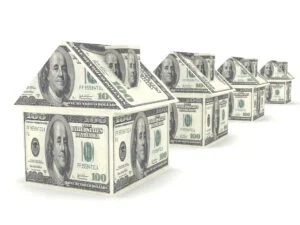
Summary: Allegheny County’s assessed property value for 2025 totals $107.54 billion, a 0.1 percent decline from 2024. The total includes $84.86 billion taxable and $22.68 billion tax-exempt. This was the first year since 2014 that taxable assessed value decreased year-over-year. The decline reinforces the need for a reassessment and regularly scheduled subsequent reassessments in Allegheny County.
According to the county assessment roll certified on Jan. 10, taxable value is comprised of $59.7 billion in residential value and $25.16 billion in commercial value. There are 583,646 total parcels in the county, of which 552,220 (95 percent) are considered taxable.
There are 130 municipalities in Allegheny County with residential and commercial land and building value. Two, McDonald and Trafford, lie partially in the county and are omitted from this analysis. One of the remaining 128 municipalities—Pennsbury Village—has only residential building value.
Of the county’s taxable value total, the City of Pittsburgh represents $20.35 billion (24 percent). There are eight other municipalities, each with over $2 billion in taxable assessed value, which equate to a total of $19.27 billion (23 percent). The remaining 119 municipalities account for $45.24 billion (53 percent).
In the absence of a reassessment, property values may change year-to-year due to new additions, improvements, demolitions, corrections and appeals by property owners or taxing bodies. An ongoing lawsuit over the calculation of the county’s Common Level Ratio (CLR) used in appeals led to a downward revision of the 2020 CLR and, with the passage of time since the 2012 reassessment which naturally leads a CLR to fall, has encouraged owners to file appeals.
The county’s taxable total decreased 0.6 percent from $85.37 billion in 2024. However, residential and commercial value moved in different directions compared to last year.
Taxable Value Changes, 2024 to 2025
| Category | 2024 ($, billions) | 2025 ($, billions) | Change ($, millions) | Change (%) |
| Residential Land | 15.67 | 15.72 | 41.58 | 0.3 |
| Residential Buildings | 43.53 | 43.98 | 452.93 | 1 |
| Commercial Land | 5.81 | 5.68 | -131.95 | -2.3 |
| Commercial Buildings | 20.36 | 19.48 | -869.7 | -4.3 |
Residential value
In 2025, residential value represented 70 percent of the taxable total. Compared to last year, residential land and building value increased by $494.51 million (0.8 percent).
The City of Pittsburgh exceeded the county average increase in residential value, rising from $10.57 billion to $10.7 billion (1.2 percent). Of the city’s 32 wards, 30 had a percentage increase in residential value. Forty-six other municipalities bested the countywide average increase. Five municipalities had a greater than 1 percent decrease year-over-year.
Commercial value
Commercial value represents the remaining 30 percent of taxable value countywide. Commercial property, specifically downtown Pittsburgh offices, has garnered plenty of attention in recent years due to COVID and the effect it had on the need for space and owners seeking assessed value reductions through appeals. More recently, the Allegheny Institute has written about efforts to convert office space to residential use and the state and local subsidies involved in those efforts.
Commercial land and building value fell from $26.17 billion to $25.16 billion, just over $1 billion (3.8 percent).
The City of Pittsburgh fell faster than the countywide average, with commercial value dropping from $10.06 billion to $9.64 billion, $416.36 million (4.1 percent). Thirty-five other municipalities decreased at an even greater percentage than the city.
How did taxable commercial building value change where it is highly concentrated? Over one-third of 2024’s commercial building value—$8.08 billion (40 percent)—was located in four Pittsburgh wards—1 (Downtown/Bluff/Duquesne University); 2 (Downtown/Part of Lower Hill District/Strip District); 4 (Oakland/Soho) and 22 (Stadium/Allegheny Center/North Side Proper) –and six municipalities—Bethel Park; Findlay; Monroeville; Moon; Robinson and Ross. Only Ward 4 and Moon saw commercial building value increase—around $30 million combined. The remaining wards and municipalities decreased year-over-year; the combined decrease was $542.5 million (49 percent).
What will cause a reassessment?
The decline in commercial value has placed a financial strain on all taxing bodies, especially Allegheny County, the City of Pittsburgh and Pittsburgh Public Schools (PPS). Not only is future property tax revenue impacted but refunds for prior years’ “over-assessments” can total in the millions.
Allegheny County increased its millage from 4.73 mills to 6.43 mills (36 percent) this year, the first change since the 2013 adjustment following the reassessment. The City of Pittsburgh and PPS did not raise taxes this year. For the remaining municipalities and school districts, the average municipal millage rate rose by 26 percent from 2013 to 2024 and the average school district millage rate rose by 22 percent from 2013-2014 to 2024-2025.
There are several factors that could bring about a reassessment in Allegheny County. Two lawsuits—one by PPS and another by a taxpayer—are seeking a court-ordered reassessment. Both point to the assessment appeals on commercial property as eroding the commercial tax base and unfairly burdening residents.
An ordinance which would initiate a property assessment assuming certain statistical conditions are met is in a County Council committee. Additionally, a co-sponsorship memorandum from an Allegheny County state senator notes legislation that would require regular property assessments every five years across the commonwealth is forthcoming.
Downtown office building conversions to residential structures may change the residential-to-commercial value ratio in the county. In addition, challenges to exempt property by the City of Pittsburgh and PPS’s potential school building closures may impact the ratio of taxable-to-exempt property. However, these policy considerations alone are unlikely to bring about a reassessment.
Despite these developments, there is an air of uncertainty as to if, or when, the desired conclusion of a reassessment is reached. Every year that passes reinforces Allegheny County’s problems with its base year and Pennsylvania’s status as an outlier on this issue. The best option is for the county government to drop opposition to the lawsuits, support—but not wait for—state legislation and pass its own ordinance for a reassessment and follow that up with reassessments at regularly scheduled intervals.
